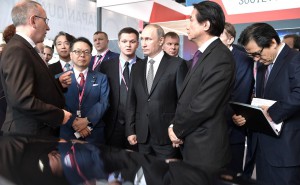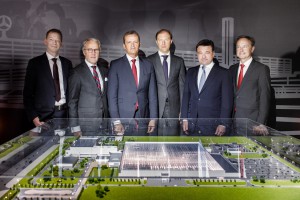
Russian President Vladimir Putin, center, listens as Nissan executives discuss plans to add 450 workers to its St. Petersburg plant.
Russia’s image as a bear is apparently being replaced by a bull, at least as far as its automotive industry is concerned. Nissan just became the latest automaker to expand its operations in the country, announcing plans to add a second shift at its plant in St. Petersburg, Russia.
The rise in the market, which has other automakers like Mercedes-Benz and Ford looking to expand or stabilize their operations in the country, has Nissan searching for another 450 workers for the plant.
“Russia has always been and remains a key strategic market for Nissan,” said Paul Willcox, chairman, Nissan Europe, while meeting with Russian government officials, including Russian President Vladimir Putin, at the International Industrial Fair Innoprom.
“Our goal remains to develop local production, increase the level of parts localization and expand export projects. This year we expect to increase production in St. Petersburg by nearly a quarter compared to last year, where the Nissan team continue to make a strong contribution to our business.”
(Daimler building new Mercedes-Benz plant in Russia. For the story, Click Here.)
The move follows Daimler AG’s recent announcement that it planned to build a new plant in the country. The German maker is investing nearly $280 million into the new factory to build new Mercedes E-Class sedans starting in 2019 with the luxury brand’s GL class sport utility vehicles following afterward.

Daimler and Russian officials show off the model for the new Mercedes-Benz plant just outside Moscow.
Mercedes and Nissan aren’t the only automakers looking to make a go of it in Russia. Ford Motor Co. and its partner, Sollers, have maintained a strong presence in Russia despite the tough times. In fact, Ford Chairman Bill Ford said the company may be expanding in Russia.
“We still have a lot of plans in Russia. We didn’t pull out, as you know. We feel very good about our operation there,” he said.
(Click Here for details about Ford moving Focus to China.)
The Russian market has suffered in recent years due, in part, to sanctions on the country from Western countries. In 2012, sales in Russia were about 3 million units and automakers were scrambling to get to the top of the heap there.
However, there have been signs of a revival of the Russian car market this year, with vehicles sales in Russian showing a positive trend since March. Overall market growth of 9.4% was recorded in March, 6.9% in April, 14.7% in May and in June – 15%.
Nissan sales in Russia have followed this trend, increasing in April, May and June by 11%, 7% and 15% respectively. Last year was the Nissan plant’s 10th anniversary and the company celebrated production of the 250,000th vehicle there. In 2016, more than 36,458 units rolled off the production line of the plant, an increase of 8% from 2015.
(To see more about how Detroit’s Big Three are dealing with adapting to a global market, Click Here.)
This result is due to the launch of production of two significant models in the last two years, the Nissan Qashqai (November 2015) and new generation Nissan Murano (June 2016). In 2016, a total of 79,066 Nissan vehicles were manufactured in Russia, exporting to the Republic of Kazakstan, the Republic of Belarus, Lebanon (from June 2016, Datsun only) and Azerbaijan (from November 2016).

Looks like a lot of colluding going on. Go get em, Chuck!